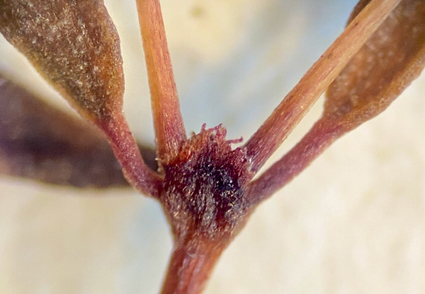Abstract
Euphorbi berryi is described and illustrated with photos. It is known from the Cerrado vegetation of Maranhão, Brazil, where it occurs on sandy soils in the municipality of Carolina at elevations of 187 to 350 m. The precise affinities of Euphorbia berryi are not clear, but it undoubtedly belongs to Euphorbia subg. Chamaesyce sect. Anisophyllum. It differs from other species of the section by the combination of being a delicate annual with the stipules united into an erose sheath; slender styles that are notched at the apex; and linear, entire, strongly falcate leaves that are scarcely asymmetrical at the base and have a white, straight to flexuous, quickly deciduous, hairlike extension at the apex. The latter feature is apparently unique in sect. Anisophyllum. Comparisons are made with Euphorbia burchellii and E. potentilloides, two species with which it has been confused. Its conservation status is preliminary assessed to be data deficient (DD) until the populations can be field evaluated.
References
Baillon, H.E. (1858) Étude générale du groupe des Euphorbiacées. V. Masson, Paris, 684 pp.
Boissier, P.E. (1860) Centuria Euphorbiarum. J.B. Baillière, Paris, B. Herman, Leipzig, 40 pp.
Duby, J.E. (1828) Botanicon Gallicum 1. Desray, Paris, 544 pp.
Frodin, D.G. (2004) History and concepts of big plant genera. Taxon 53: 753–756. https://doi.org/10.2307/4135449
IUCN (2022) Guidelines for using the IUCN red list categories and criteria. Version 15. Prepared by the Standards and Petitions Subcommittee of the IUCN Species Survival Commission. IUCN, Gland and Cambridge. Available from: http://www.iucnredlist.org/documents/RedListGuidelines.pdf (accessed 22 January 2022)
Lamarck, J.B.A.P.M. (1788) Encyclopédie Méthodique, Botanique 2 (2). Panckoucke, Paris & Liège, pp. 401–744.
Linnaeus, C. (1753) Species Plantarum. Laurentius Salvius, Stockholm, 1200 pp.
Müller Argoviensis, J. (1874) Euphorbiaceae. In: Martius, C.F.P. von & Eichler, A.W. (Eds.) Flora Brasiliensis 11 (2). Frid. Fleischer, München, 752 pp.
Schlechtendal, D.F.L. (1847[1846]) Plantae Leiboldianae. Linnaea 19: 234–312.
Silva, M.J. da, Feitosa, G.L. & Riina, R. (2021) Seek and you shall find: rediscovery of the Brazilian Euphorbia burchellii (Euphorbiaceae) after nearly a century and a half, with a conspectus of Euphorbia sect. Anisophyllum species in the state of Goiás, Brazil. Phytotaxa 479: 83–94. https://doi.org/10.11646/phytotaxa.479.1.6
Silva, O.L.M., Torres, D.S.C, Hurbath, F., Cordeiro, I. & Riina, R. (2020) Euphorbia. In: Flora do Brasil. Jardim Botânico do Rio de Janeiro. Available from: http://floradobrasil.jbrj.gov.br/reflora/floradobrasil/FB17561 (accessed 22 January 2022)
Thiers, B. (2022 [continuously updated]) Index Herbariorum: a global directory of public herbaria and associated staff. New York Botanical Garden’s Virtual Herbarium. The New York Botanical Garden, Bronx. Available from: http://sweetgum.nybg. org/science/ih/ (accessed 22 January 2022).
Turland, N.J., Wiersema, J.H., Barrie, F.R., Greuter, W., Hawksworth, D.L., Herendeen, P.S., Knapp, S., Kusber, W.-H., Li, D.-Z., Marhold, K., May, T.W., McNeill, J., Monro, A.M., Prado, J., Price, M.J. & Smith, G.F. (2018) International Code of Nomenclature for Algae, Fungi, and Plants (Shenzhen Code). Adopted by the Nineteenth International Botanical Congress Shenzhen, China, July 2017. Regnum Vegetabile 159. Koeltz Botanical Books: Glashütten, Germany. https://doi.org/10.12705/Code.2018
Villaseñor, J.L. (2016) Checklist of the native vascular plants of Mexico. Revista Mexicana de Biodiversidad 87: 559–902. https://doi.org/10.1016/j.rmb.2016.06.017
Yang, Y., Riina, R., Morawetz, J.J., Haevermans, T., Aubriot, X. & Berry, P.E. (2012) Molecular phylogenetics and classification of Euphorbia subgenus Chamaesyce (Euphorbiaceae). Taxon 61: 764–789. https://doi.org/10.1002/tax.61400


